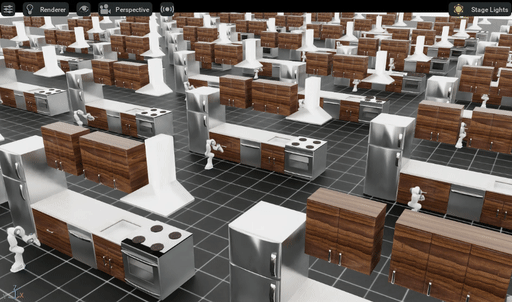Using Scenes in Isaac Lab for RL
We show how to use a generated USD to be used in an RL workflow in Isaac Lab. We start by generating a scene and exporting it to a USD file:
import numpy as np
import trimesh.transformations as tra
from scene_synthesizer import utils
from scene_synthesizer import procedural_scenes as ps
# Generate a random kitchen with one joint
#
# Note: There is no reason to have just one joint in the kitchen,
# other than in this particular example we will need to list all the joints
# later in the Isaac Lab InteractiveScene.
# An arbitrary number of joints is possible, but the code later in this example
# would need to be adapted accordingly.
#
while True:
k = ps.kitchen_single_wall()
# Remove all joints except the ones pertaining to the base cabinet
k.remove_joints('^(?!base_cabinet/).*')
# check if exactly one joint is left
if len(k.get_joint_names()) == 1:
break
# Move the origin of the scene (where the robot will be located)
# to be one meter in front of the actuated base cabinet
T = tra.translation_matrix((1.0, 0, 0)) \
@ tra.euler_matrix(0, 0, -np.pi/2.0) \
@ utils.homogeneous_inv(k.get_transform('base_cabinet'))
k.add_base_frame_transform(T)
# export to USD
k.export('/tmp/kitchen_with_one_joint.usd')
Note, that we can now also attach MDL materials as shown in a previous example to make the scene a bit more visually pleasing.
Next, we create a Manager-Based RL Environment.
To do so we need to create an InteractiveScene and explicitly register all articulations and rigid bodies.
We base our example on the Issac-open-Drawer-Franka-v0.
After copying the environment, make sure that the cabinet scene cabinet_env_cfg.py looks like this:
@configclass
class CabinetSceneCfg(InteractiveSceneCfg):
"""Configuration for the kitchen scene with a robot and a kitchen.
This is the abstract base implementation, the exact scene is defined in the derived classes
which need to set the robot and end-effector frames
"""
# robots, Will be populated by agent env cfg
robot: ArticulationCfg = MISSING
# End-effector, Will be populated by agent env cfg
ee_frame: FrameTransformerCfg = MISSING
kitchen = AssetBaseCfg(
prim_path="{ENV_REGEX_NS}/Kitchen",
# Make sure to set the correct path to the generated scene
spawn=sim_utils.UsdFileCfg(usd_path="/tmp/kitchen_with_joint.usd"),
)
cabinet = ArticulationCfg(
prim_path="{ENV_REGEX_NS}/Kitchen/base_cabinet",
# By doing spawn=None we're just registering the articulation, in this case one cabinet with a single joint
spawn=None,
init_state=ArticulationCfg.InitialStateCfg(
# Make sure that this is the exact transformation of the base_cabinet
# ie. scene.get_transform('base_cabinet')
pos=(1.0, 0, 0),
rot=(0.70710678, 0., 0., -0.70710678),
joint_pos={
# Make sure that this is the correct joint name
# ie. scene.get_joint_names('base_cabinet')
"corpus_to_drawer_0_0": 0.0,
},
),
actuators={
"drawers": ImplicitActuatorCfg(
# Make sure that this is the correct joint name
# ie. scene.get_joint_names('base_cabinet')
joint_names_expr=["corpus_to_drawer_0_0"],
effort_limit=87.0,
velocity_limit=100.0,
stiffness=10.0,
damping=1.0,
),
},
)
# Frame definitions for the cabinet.
cabinet_frame = FrameTransformerCfg(
prim_path="{ENV_REGEX_NS}/Kitchen/base_cabinet/drawer_0_0",
debug_vis=False,
visualizer_cfg=FRAME_MARKER_SMALL_CFG.replace(prim_path="/Visuals/CabinetFrameTransformer"),
target_frames=[
FrameTransformerCfg.FrameCfg(
prim_path="{ENV_REGEX_NS}/Kitchen/base_cabinet/drawer_0_0",
name="drawer_handle_top",
offset=OffsetCfg(
pos=(0.0, -0.05, 0.01),
# rot=(0.5, 0.5, -0.5, -0.5), # align with end-effector frame
),
),
],
)
# plane
plane = AssetBaseCfg(
prim_path="/World/GroundPlane",
init_state=AssetBaseCfg.InitialStateCfg(),
spawn=sim_utils.GroundPlaneCfg(),
collision_group=-1,
)
# lights
light = AssetBaseCfg(
prim_path="/World/light",
spawn=sim_utils.DomeLightCfg(color=(0.75, 0.75, 0.75), intensity=3000.0),
)
Make sure to also replace the joint_names in the ObsTerm defined in ObservationsCfg.
Also substitue the proper joint_names in the RewTerm representing the open_drawer_bonus and multi_stage_open_drawer.
In rewards.py replace all occurences of
drawer_pos = env.scene[asset_cfg.name].data.joint_pos[:, asset_cfg.joint_ids[0]]
#
# with
#
joint_index = asset_cfg.joint_ids[0] if not isinstance(asset_cfg.joint_ids, slice) else 0
drawer_pos = env.scene[asset_cfg.name].data.joint_pos[:, joint_index]
to avoid a TypeError if the asset has just one joint (as in our case).
Finally, increase the spacing of the scenes in the scene settings (e.g. use env_spacing=5.0).
The resulting environment can then be run with a random agent:
python source/standalone/environments/random_agent.py \
--task Isaac-Open-Drawer-Franka-v0 \
--num_envs 100 \

Check the Isaac Lab documentation for further details.